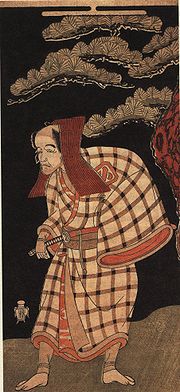
Katsukawa Shunsho
Encyclopedia

Ukiyo-e
' is a genre of Japanese woodblock prints and paintings produced between the 17th and the 20th centuries, featuring motifs of landscapes, tales from history, the theatre, and pleasure quarters...
style, and the leading artist of the Katsukawa school
Katsukawa school
The Katsukawa school was a school of Japanese ukiyo-e art, founded by Miyagawa Shunsui. It specialized in paintings and prints of kabuki actors , sumo wrestlers, and beautiful women ....
. Shunshō studied under Miyagawa Shunsui
Miyagawa Shunsui
"Shunsui" redirects here. For the 19th c. doban artist, see Yomo Shunsui; for the writer, see Tamenaga Shunsui; for the anime character, see Shunsui Kyōraku....
, son and student of Miyagawa Chōshun
Miyagawa Choshun
was a Japanese painter in the ukiyo-e style. Founder of the Miyagawa school, he and his pupils are among the few ukiyo-e artists to have never created woodblock prints. He was born in Miyagawa, in Owari province, but lived much of his later life in Edo, where he died...
, both equally famous and talented ukiyo-e artists. Shunshō is most well known for introducing a new form of yakusha-e
Yakusha-e
Yakusha-e , often referred to as "actor prints" in English, are Japanese woodblock prints or, rarely, paintings, of kabuki actors, particularly those done in the ukiyo-e style popular through the Edo period and into the beginnings of the 20th century...
, prints depicting Kabuki
Kabuki
is classical Japanese dance-drama. Kabuki theatre is known for the stylization of its drama and for the elaborate make-up worn by some of its performers.The individual kanji characters, from left to right, mean sing , dance , and skill...
actors. However, his bijinga
Bijinga
Bijinga , is a generic term for pictures of beautiful women in Japanese art, especially in woodblock printing of the ukiyo-e genre, which predate photography...
(images of beautiful women) paintings, while less famous, are said by some scholars to be "the best in the second half of the
Shunshō first came to Edo
Edo
, also romanized as Yedo or Yeddo, is the former name of the Japanese capital Tokyo, and was the seat of power for the Tokugawa shogunate which ruled Japan from 1603 to 1868...
to study haiku
Haiku
' , plural haiku, is a very short form of Japanese poetry typically characterised by three qualities:* The essence of haiku is "cutting"...
and painting. He became a noted printmaker of actors with his first works dating from 1760. Though originally a member of the Torii school
Torii school
This article is about a school of ukiyo-e art; for the sculpture style, see Tori style. For the Torii samurai clan, see Torii family.The Torii school was a school of ukiyo-e painting and printing founded in Edo...
, he soon broke away and began his own style, which would later be dubbed the Katsukawa school. Among his students were the famous ukiyo-e artists Shunchō
Katsukawa Shuncho
was a Japanese designer of ukiyo-e style Japanese woodblock prints, who was active from about 1783 to about 1795.Although a student of Katsukawa Shunshō, Shunchō's output, which consists mostly of prints of beautiful women, more closely resembles the work of Torii Kiyonaga.Shunchō also designed...
, Shun'ei, and Hokusai
Hokusai
was a Japanese artist, ukiyo-e painter and printmaker of the Edo period. He was influenced by such painters as Sesshu, and other styles of Chinese painting...
.
Most of Shunshō's actor prints are in the hoso-e (33x15cm) format common at the time, but he created a great number of works in triptych or pentaptych
Polyptych
A polyptych generally refers to a painting which is divided into sections, or panels. The terminology that follows is in relevance to the number of panels integrated into a particular piece of work: "diptych" describes a two-part work of art; "triptych" describes a three-part work; "tetraptych"...
sets. The depiction of large portrait-style heads and the insides of actors' dressing rooms is what truly set his work apart from that of earlier artists, however. He was also one of the first to pioneer realistic depictions of actors; in Shunshō's prints, unlike in the works of the Torii school, it was possible for the first time to distinguish not only the theatrical role, but also the actor portraying that role. Shunshō also made use often of the long and narrow hashira-e format.
Though he painted many revered paintings of bijin
Bijinga
Bijinga , is a generic term for pictures of beautiful women in Japanese art, especially in woodblock printing of the ukiyo-e genre, which predate photography...
, he produced very few prints depicting the same. Seirō Bijin Awase Sugata Kagami (晴朗美人あわせ鏡, "A Mirror Reflecting the Forms of Fair Women of the Green-Houses"), a printed book on which he collaborated with Kitao Shigemasa
Kitao Shigemasa
was a Japanese ukiyo-e artist from Edo. He was one of the leading printmakers of his day, but his works have been slightly obscure. He is noted for paintings of geisha. He was taught by Shigenaga and has been referred to as "a chameleon" who adopted to changing styles. He was less active after the...
, is one of the only printed works containing bijinga by Shunshō. His paintings not only depicted elegantly painted women and fashions, but great attention is also paid to the landscape elements and architecture of the backgrounds. Though his prints belie a strong fascination with the theatre world, his paintings suggest the complete opposite.
Names
Originally Katsumiyagawa Yūsuke, "Katsukawa Shunshō" is one of many art-nameArt-name
An art-name is a pseudonym, or penname, used by an East Asian artist, which they sometimes change. The word and the idea to use a pseudonym originated from China, then became popular in other East Asian countries ....
s (gō) taken on by the artist during his life. Others include Jūgasei, Ririn, Yūji, Kyokurōsei, and Rokurokuan. Prior to signing his works with one of these gō, he used a stamp in the shape of a gourd surrounding the character mori (森), meaning "forest."

